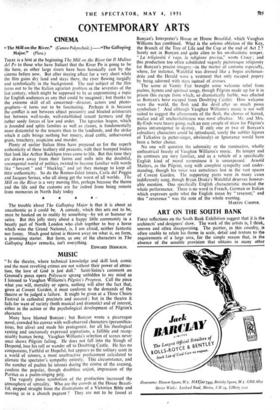ART ON THE SOUTH BANK
FIRST reflections on the South Bank Exhibition suggest that it is the architects' and designers' show. The work of the artists is, I think, uneven and often disappointing. The painter, in this country, is often unable to relate his theme in scale, detail and texture to the requirements of a large area, for the simple reason that, in the absence of the sensible provision that obtains in many other countries, whereby a proportion of the cost of every new building is devoted to mural or sculptural decoration, he is unable ,to gain experience in the field. It is, however, only fair to the artists to point out that many of the murals on the South Bank just cannot be seen properly. For example, Leonard Rosoman's long, gentle and luminous painting of the unrolling of the seasons, in the Countryside Pavilion, is punctuated in front by a series of upright girders, four partial figures by F. E. McWilliam, and a whole row of brightly painted tractors popping up and down on giant jacks.
Some of the omissions and commissions surprise. However, quite a number of our best painters have been employed, and quite a number of youngsters given their chance. Sutherland prefaces the " origins of the land " at the very outset of the exhibition with " the forces of nature " ; John Piper has covered a theatrically large area with a suitably theatrical version of " the Englishman's home." Among the sculptori Moore, Epstein and Barbara Hep- worth are represented. The least satisfactory murals are those conceived as purely representational easel pictures enlarged in size. These vary from art-school sketch-club standards to Charles Mozley's gallant 33 ft. by 28 ft. effort on Florence Nightingale. Feliks Topolski's vast " Cavalcade of Commonwealth," too, a heaving turmoil of figures ranged through the colours of the spec- trum, is too confused to be digestible. More decorative modes that take account of the picture surface survive better. Edward Bawden,- Kenneth Rowntrce and John Minton, for example, in the suave Lion and Unicorn building and the Dome respectively, have all achieved comfortably what they aimed at. Julian Trevelyan has made a gay design round the subject of beer, for the Turntable Café ; James Boswell has achieved his ends with a minimum of means.
Some of the painters have been unable to push their designs to a conclusion, or just have not taken enough care. John Hutton had a good idea when he planned a double-purpose mural that would register at one level across the river, and at another close-to. In the result it looks like a poster hoarding from afar and an unfinished sketch from nearby. Messrs. Kempster and Evans, with their twelve paintings of the months of the year, are an all too rare example of craftsmanship and an exact judgement in relating content to size. In several places the division between mediums becomes tenuous. Foreign visitors, if they notice Victor Pasmore's tiled whorls in black and white, will be hard put to it to understand our respect for him as a painter. Technical experiment—so noticeable and so exciting in some of the architecture—is not greatly in evidence. Siegfried Charoux's colossal group of " The Islanders " might almost qualify by reason of its size ; abstracts and mobiles by Reg. Butler and Lynn Chadwick for other reasons. Richard Huws has evolved a hydraulic, sheet- metal water-mobile. The " Seaside" section has an admirable sgraffito mural by Augustus Lunn, and an attractive mosaic com- posed of pebble, shell and rope, by John Binns. On the whole the sculptors (and even this short list shOuld, include the names of Maurice Lambert and Karin Jonzen) are displayed to better advan- age than the painters. M. H. MIDDLETON.



































 Previous page
Previous page